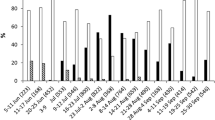Summary
Factors affecting oophagy among siblings in the land snail Arianta arbustorum were studied in 3 populations from different altitudes in Switzerland. The degree of egg cannibalism in A. arbustorum is a function of hatching asynchrony since the earliest hatched snails will devour the unhatched eggs in the same clutch. Clutch size, egg density and amount of vegetable food available to newly hatched snails did not affect the degree of cannibalism. Snails from 3 populations were similar in terms of incubation time and intrinsic hatching asynchrony of the clutches. However, they differed in degree of cannibalism when the hatching asynchrony had been experimentally increased. Snails from a lowland forest showed a higher degree of cannibalism than did those from an alpine mountain slope. The parent snails differed in terms of incubation time and hatching synchrony in their clutches. Under natural conditions, the length of the hatching spread and, as a result, the degree of cannibalism will depend additionally on the mode of oviposition (batches or single; clumped or dispersed), on the spatial heterogeneity of egg-laying places and on climatic conditions (e.g. drought).
Similar content being viewed by others
References
Alyakrinskaya IO (1981) Egg nutrient content in gastropods. Dokl Akad Nauk SSSR 260:245–248
Andreassen EM (1981) Population dynamics of Arianta arbustorum and Cepaea hortensis in western Norway. Fauna norv Ser A 2:1–13
Banks CJ (1956) Observations on the behaviour and mortality in Coccinellidae before dispersal from the egg shells. Proc Roy Ent Soc Lond A 31:56–60
Baur B (1984a) Dispersion, Bestandesdichte und Diffusion bei Arianta arbustorum (L.) (Mollusca, Pulmonata). PhD Thesis Univ of Zürich
Baur B (1984b) Shell size and growth rate differences for alpine populations of Arianta arbustorum (L.) (Pulmonata: Helicidae). Rev suisse Zool 91:37–46
Baur B (1986) Patterns of dispersion, density and dispersal in alpine populations of the land snail Arianta arbustorum (L.) (Helicidae). Holarct Ecol (in press)
Bayne CJ (1969) Survival of the embryos of the grey field slug Agriolimax reticulatus, following desiccation of the egg. Malacologia 9:391–401
Bobisud LE (1976) Cannibalism as an evolutionary strategy. Bull Math Biol 38:359–368
Burla H (1984) Induced environmental variation in Arianta arbustorum (L.). Genetica 64:65–67
Burla H, Stahel W (1983) Altitudinal variation in Arianta arbustorum (Mollusca, Pulmonata) in the Swiss Alps. Genetica 62:95–108
Carrick R (1938) The life-history and development of Agriolimax agrestis, the grey field slug. Trans Roy Soc Edinb 59:563–597
Carrick R (1942) The grey field slug, Agriolimax agrestis L., and its environment. Ann appl Biol 29:43–55
Didier B, Rondelaud D (1983) Les effets d'un aliment composé sur la fécondité et la croissance de Zonitoides nitidus (Müller). Haliotis 13:25–28
Duncan CJ (1975) Reproduction. In: Fretter V, Peake J (eds) Pulmonates Vol 1. Academic Press, London, pp 309–365
Eickwort KR (1973) Cannibalism and kin selection in Labidomera clivicollis (Coleoptera: Chrysomelidae). Am Nat 107:452–453
Fox LR (1975) Cannibalism in natural populations. Ann Rev Ecol Syst 6:87–106
Frömming E (1954) Biologie der mitteleuropäischen Landgastropoden. Duncker & Humblot, Berlin, p 404
Grime JP, Blythe GM (1969) An investigation of the relationships between snails and vegetation at the Winnats pass. J Ecol 57:45–66
Herzberg F, Herzberg A (1962) Observations on reproduction in Helix aspersa. Am Midl Nat 68:297–306
Jones JS (1982) Of cannibals and kin. Nature 299:202–203
Kerney MP, Cameron RAD (1979) A field guide to the land snails of Britain and north-west Europe. Collins, London, p 288
Lindquist B (1941) Experimentelle Untersuchungen über die Bedeutung einiger Landmollusken für die Zersetzung der Waldstreu. Kungl Fysiogr Sallsk Lund Forth 11:144–156
Mason CF (1970) Food, feeding rates and assimilation in woodland snails. Oecologia (Berlin) 4:358–373
O'Connor R (1978) Brood reduction in birds: selection for fratricide, infanticide and suicide. Anim Behav 26:79–96
Polis GA (1981) The evolution and dynamics of intraspecific predation. Ann Rev Ecol Syst 12:225–251
Pollard E (1975) Aspects of the ecology of Helix pomatia L. J Anim Ecol 44:305–329
Raboud C (1985) Demographische Altersverteilung bei Arianta arbustorum (L.) (Mollusca, Pulmonata) in Abhängigkeit von der Höhe über Meer. PhD Thesis Univ of Zürich
Rondelaud D (1980) Données complémentaires sur l'éco-éthologie d'Oxychilus draparnaudi Beck (Mollusque, Pulmoné): Proposition d'une nouvelle technique d'élevage. Haliotis 10:45–48
Skurdal J, Bleken E, Stenseth NC (1985) Cannibalism in whitefish (Coregonus lavaretus). Oecologia (Berlin) 67:566–571
South A (1965) Biology and ecology of Agriolimax reticulatus (Müll.) and other slugs: spatial distribution. J anim Ecol 34:403–417
Stenseth NC (1985) On the evolution of cannibalism. J theor Biol 115:161–177
Stenseth NC, Reed J (1978) A comment on Bobisud's paper on evolution of cannibalism. Bull Math Biol 40:541–545
Wolda H (1965) The effect of drought on egg production in Cepaea nemoralis (L.). Arch Néerl Zool 16:337–399
Yom-Tov Y (1971) The biology of two desert snails Trochoidea (Xerocrassa) seetzeni and Sphincterochila boissieri. Israel J Zool 20:231–248
Author information
Authors and Affiliations
Rights and permissions
About this article
Cite this article
Baur, B., Baur, A. Proximate factors influencing egg cannibalism in the land snail Arianta arbustorum (Pulmonata, Helicidae). Oecologia 70, 283–287 (1986). https://doi.org/10.1007/BF00379252
Received:
Issue Date:
DOI: https://doi.org/10.1007/BF00379252




